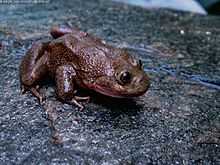Telmatobius
| Telmatobius | |
|---|---|
 | |
| Telmatobius species from altiplan lakes in northern Chile. | |
| Scientific classification | |
| Kingdom: | Animalia |
| Phylum: | Chordata |
| Class: | Amphibia |
| Order: | Anura |
| Family: | Leptodactylidae |
| Subfamily: | Telmatobiinae |
| Genus: | Telmatobius Wiegmann, 1834 |
| Species | |
|
More than 50, see text. | |
Telmatobius is a genus of frogs native to the Andean highlands in South America, where they are found in Ecuador, Peru, Bolivia, northwestern Argentina and northern Chile. All species are closely associated with water and some are entirely aquatic. It contains more than 50 species; the vast majority seriously threatened, especially from habitat loss, pollution, diseases (chytridiomycosis and nematode infections) and capture for human consumption. The huge Titicaca Water Frog (T. culeus), made famous by Jacques Cousteau, also faces these risks. The three Ecuadorian species have not been seen for years and may already be extinct: T. cirrhacelis last seen in 1981, T. niger in 1994 and T. vellardi in 1987.
The genus was first described by Arend Friedrich August Wiegmann in 1834. Telmatobius resembles Batrachophrynus (another Andean genus), and based on genetic evidence the latter should be merged into the former.
Species
- Telmatobius arequipensis Vellard, 1955
- Telmatobius atacamensis Gallardo, 1962
- Telmatobius atahualpai Wiens, 1993
- Telmatobius brevipes Vellard, 1951
- Telmatobius brevirostris Vellard, 1955
- Telmatobius carillae Morales, 1988
- Telmatobius ceiorum Laurent, 1970
- Telmatobius chusmisensis Formas, Cuevas & Nunez, 2006
- Telmatobius cirrhacelis Trueb, 1979
- Telmatobius colanensis Wiens, 1993
- Telmatobius contrerasi Cei, 1977
- Telmatobius culeus (Garman, 1875)
- Telmatobius dankoi Formas, Northland, Capetillo, Nuñez, Cuevas & Brieva, 1999
- Telmatobius degener Wiens, 1993
- Telmatobius edaphonastes De la Riva, 1995
- Telmatobius espadai De la Riva, 2005
- Telmatobius fronteriensis Benavides, Ortiz & Formas, 2002
- Telmatobius gigas Vellard, 1969
- Telmatobius halli Noble, 1938
- Telmatobius hauthali Koslowsky, 1895
- Telmatobius hockingi Salas & Sinsch, 1996
- Telmatobius huayra Lavilla & Ergueta-Sandoval, 1995
- Telmatobius hypselocephalus Lavilla & Laurent, 1989
- Telmatobius ifornoi Lavilla & Sandoval, 1999
- Telmatobius ignavus Barbour & Noble, 1920
- Telmatobius intermedius Vellard, 1951
- Telmatobius jahuira Lavilla & Ergueta-Sandoval, 1995
- Telmatobius jelskii (Peters, 1873)
- Telmatobius laticeps Laurent, 1977
- Telmatobius latirostris Vellard, 1951
- Telmatobius marmoratus (Duméril & Bibron, 1841)
- Telmatobius mayoloi Salas & Sinsch, 1996
- Telmatobius necopinus Wiens, 1993
- Telmatobius niger Barbour & Noble, 1920
- Telmatobius oxycephalus Vellard, 1946
- Telmatobius pefauri Veloso M. & Trueb, 1976
- Telmatobius peruvianus Wiegmann, 1834
- Telmatobius philippii Cuevas & Formas, 2002
- Telmatobius pinguiculus Lavilla & Laurent, 1989
- Telmatobius pisanoi Laurent, 1977
- Telmatobius platycephalus Lavilla & Laurent, 1989
- Telmatobius rimac Schmidt, 1954
- Telmatobius schreiteri Vellard, 1946
- Telmatobius scrocchii Laurent & Lavilla, 1986
- Telmatobius sibiricus De la Riva & Harvey, 2003
- Telmatobius simonsi Parker, 1940
- Telmatobius stephani Laurent, 1973
- Telmatobius thompsoni Wiens, 1993
- Telmatobius truebae Wiens, 1993
- Telmatobius vellardi Munsterman & Leviton, 1959
- Telmatobius vilamensis Formas, Benavides & Cuevas, 2003
- Telmatobius yuracare De la Riva, 1994
- Telmatobius zapahuirensis Veloso, Sallaberry, Navarro, Iturra, Valencia, Penna & Diaz, 1982
Referecences
- Angulo (2009). Conservation Needs of Batrachophrynus and Telmatobius Frogs of the Andes of Peru. Conservation and Society. 6(4): 328-333.
- Stuart, Hoffmann, Chanson, Cox, Berridge, Ramani and Young, editors (2008). Threatened Amphibians of the World. ISBN 978-84-96553-41-5
External links
| Wikispecies has information related to: Telmatobius |